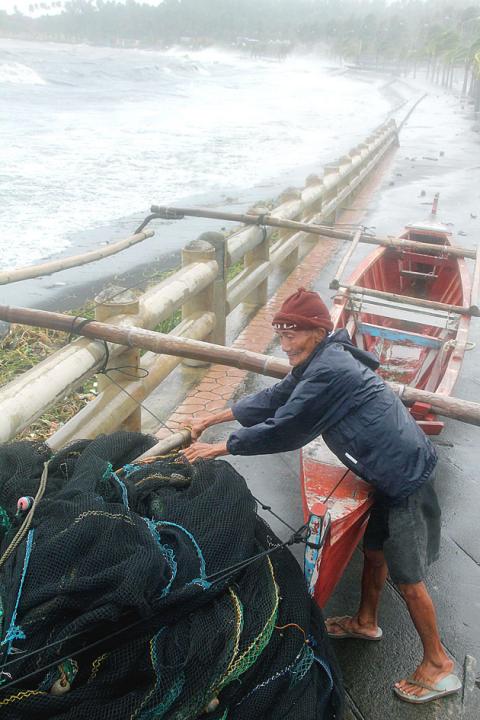One of the most intense typhoons on record whipped the Philippines yesterday, killing at least three people and terrifying millions as monster winds tore apart homes.
Super Typhoon Haiyan smashed into coastal communities on the central island of Samar, about 600km southeast of Manila, before dawn yesterday, with maximum sustained winds of about 315kph.
“It was frightening. The wind was so strong, it was so loud, like a screaming woman. I could see trees being toppled down,” said Liwayway Sabuco, a saleswoman from Catbalogan, a major city on Samar.

Photo: AFP
The government said three people had been confirmed killed and another man was missing after he fell off a gangplank in the central port of Cebu.
However, the death toll was expected to rise, with authorities unable to immediately contact the worst-affected areas and Haiyan only expected to leave the Philippines in the evening.
An average of 20 major storms or typhoons, many of them deadly, batter the Philippines each year. The developing country is particularly vulnerable because it is often the first major landmass for the storms after they build over the Pacific Ocean.
The Philippines suffered the world’s strongest storm last year, when Typhoon Bopha left about 2,000 people dead or missing on the southern island of Mindanao.
However, Haiyan’s wind strength made it one of the four most-powerful typhoons ever recorded in the world, and the most intense to have made landfall, said Jeff Masters, the director of meteorology at US-based Weather Underground.
Haiyan generated wind gusts of 379kph yesterday morning, the US Navy’s Joint Typhoon Warning Center said.
Masters said the previous record for the strongest typhoon to make landfall was Hurricane Camille, which hit Mississippi in the US with sustained winds of 305kph in 1969.
In Tacloban, a city of more than 200,000 people close to where Haiyan made landfall, corrugated iron sheets were ripped off roofs and floated with the wind before crashing into buildings, according to video footage taken by a resident.
Flash floods also turned Tacloban’s streets into rivers, while a photo from an ABS-CBN television reporter showed six bamboo houses washed away along a beach more than 200km to the south.
Authorities expressed initial confidence that the death toll from Haiyan would not climb dramatically, citing a massive effort starting two days before the typhoon hit to evacuate those in vulnerable areas and make other preparations.
More than 718,000 people had sought shelter in evacuation centers, 3,000 ferries had been locked down at ports and hundreds of flights were canceled, the national disaster management council’s spokesman Reynaldo Balido said.
“In terms of damage, we cannot avoid that... but the silver lining here is that the casualties are only three as of now,” he said in Manila.
“It is possible that this will increase, but we don’t think it will increase that much more, unlike in previous typhoons. The people have learnt their lesson,” he said.
Another reason for optimism was that Haiyan did not bring extreme rains, which is typically the major cause of deaths for typhoons in the Philippines.
Nevertheless, Balido said disaster officials had yet to make contact with many cities and towns that were believed to have been badly damaged, and it was impossible to get a clear picture of the damage yesterday evening.
The International Organization for Migration also warned that widespread damage and casualties was likely.
It said one particularly vulnerable area in Haiyan’s path was the central island of Bohol, the epicenter of a magnitude 7.1 earthquake last month that killed 222 people and where 350,000 people were living in temporary shelters.
Haiyan was forecast to exit the Philippines after 9pm and into South China Sea, tracking toward Vietnam and Laos.

The US government has signed defense cooperation agreements with Japan and the Philippines to boost the deterrence capabilities of countries in the first island chain, a report by the National Security Bureau (NSB) showed. The main countries on the first island chain include the two nations and Taiwan. The bureau is to present the report at a meeting of the legislature’s Foreign Affairs and National Defense Committee tomorrow. The US military has deployed Typhon missile systems to Japan’s Yamaguchi Prefecture and Zambales province in the Philippines during their joint military exercises. It has also installed NMESIS anti-ship systems in Japan’s Okinawa

‘WIN-WIN’: The Philippines, and central and eastern European countries are important potential drone cooperation partners, Minister of Foreign Affairs Lin Chia-lung said Minister of Foreign Affairs Lin Chia-lung (林佳龍) in an interview published yesterday confirmed that there are joint ventures between Taiwan and Poland in the drone industry. Lin made the remark in an exclusive interview with the Chinese-language Liberty Times (the Taipei Times’ sister paper). The government-backed Taiwan Excellence Drone International Business Opportunities Alliance and the Polish Chamber of Unmanned Systems on Wednesday last week signed a memorandum of understanding in Poland to develop a “non-China” supply chain for drones and work together on key technologies. Asked if Taiwan prioritized Poland among central and eastern European countries in drone collaboration, Lin

ON ALERT: Taiwan’s partners would issue warnings if China attempted to use Interpol to target Taiwanese, and the global body has mechanisms to prevent it, an official said China has stationed two to four people specializing in Taiwan affairs at its embassies in several democratic countries to monitor and harass Taiwanese, actions that the host nations would not tolerate, National Security Bureau (NSB) Director-General Tsai Ming-yen (蔡明彥) said yesterday. Tsai made the comments at a meeting of the legislature’s Foreign Affairs and National Defense Committee, which asked him and Minister of National Defense Wellington Koo (顧立雄) to report on potential conflicts in the Taiwan Strait and military preparedness. Democratic Progressive Party (DPP) Legislator Michelle Lin (林楚茵) expressed concern that Beijing has posted personnel from China’s Taiwan Affairs Office to its

BACK TO WORK? Prosecutors said they are considering filing an appeal, while the Hsinchu City Government said it has applied for Ann Kao’s reinstatement as mayor The High Court yesterday found suspended Hsinchu mayor Ann Kao (高虹安) not guilty of embezzling assistant fees, reducing her sentence to six months in prison commutable to a fine from seven years and four months. The verdict acquitted Kao of the corruption charge, but found her guilty of causing a public official to commit document forgery. The High Prosecutors’ Office said it is reviewing the ruling and considering whether to file an appeal. The Taipei District Court in July last year sentenced Kao to seven years and four months in prison, along with a four-year deprivation of civil rights, for contravening the Anti-Corruption